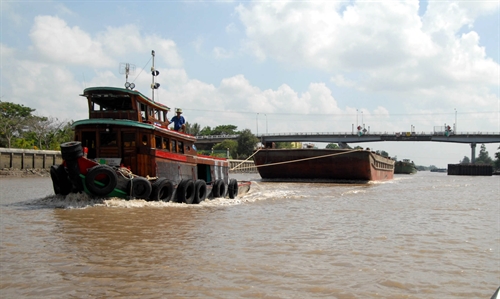 Society
Society

About 251 bridges nationwide are facing the risk of collapse from collision with waterway vehicles because of their low clearance heights, the Việt Nam Inland Waterways Administration (Viwa) said.
 |
| Chợ Gạo bridge in the Mekong Delta province of Tiền Giang. Many low-clearance bridges in the country risk collapse in light of recent incidents involving ship collisions. — VNA/VNS Photo Thanh Vũ |
HÀ NỘI (VNS) — About 251 bridges nationwide are facing the risk of collapse from collision with waterway vehicles because of their low clearance heights, the Việt Nam Inland Waterways Administration (Viwa) said.
The risks are particularly high in the central and southern regions as a result of floods and tides that raise the water level, thus reducing the clearance heights of bridges.
Ninety-four dilapidated bridges have been categorised as top priority for the repair work, Deputy Head of the administration Trần Văn Thọ said.
Lê Phương Nam, manager of Bình Lợi railway section on Bình Lợi Bridge in HCM City, told Tiền Phong (Vanguard) newspaper that during low tide, the clearance height of the bridge was 3.5m, but during high tides, this was reduced to just 1m.
The Ghềnh Railway Bridge in the southern Đồng Nai Province, a key bridge on the North-South railway line, collapsed on March 20 after a barge crashed into one of its pillars. Railway services have been affected by the accident.
On March 7, a ship with tonnage of 3000 tonnes was travelling on An Thái River from the northern Hải Dương Province to the northern port city of Hải Phòng, when it hit An Thái Bridge. No loss of human life was reported, but the crash caused a girder of the bridge to crack, affecting traffic near the site and putting the bridge at risk of collapse.
Poor management of the operation of waterway vehicles by localities was to blame for the incident.
According to figures from the Việt Nam Register, the country has more than 240,000 waterway vehicles, but 62 per cent of them are not registered.
Many sailors also did not have professional training and certificates, head of Viwa Hoàng Hồng Giang said.
The management of sailors was the most important factor to ensure waterway safety, he said.
At a meeting held last week, Deputy Minister of Transport Nguyễn Hồng Trường asked Viwa should take more effective and urgent measures to prevent such accidents.
He said Viwa should initially check all areas that faced a high risk of collision between bridges and waterway vehicles and finalise the warning systems for such vehicles.
Waterway vehicles must be strictly banned from areas where bridges failed to meet the required standards, he said, adding that firms whose vehicles violated the ban would have their business licences revoked.
Relevant ministries and agencies should check and report to the ministry before April 30 about the bridges that were vulnerable to collision with waterway vehicles and also collapse, he said.
Trường said there was need for more state management efficiency in the operation of waterway vehicles and sailors.
The ministry said the Prime Minister should continue to provide a credit package, apart from official development assistance capital, for the upgrade of dilapidated bridges, with priority being given to railway bridges and those with low clearance heights. — VNS




